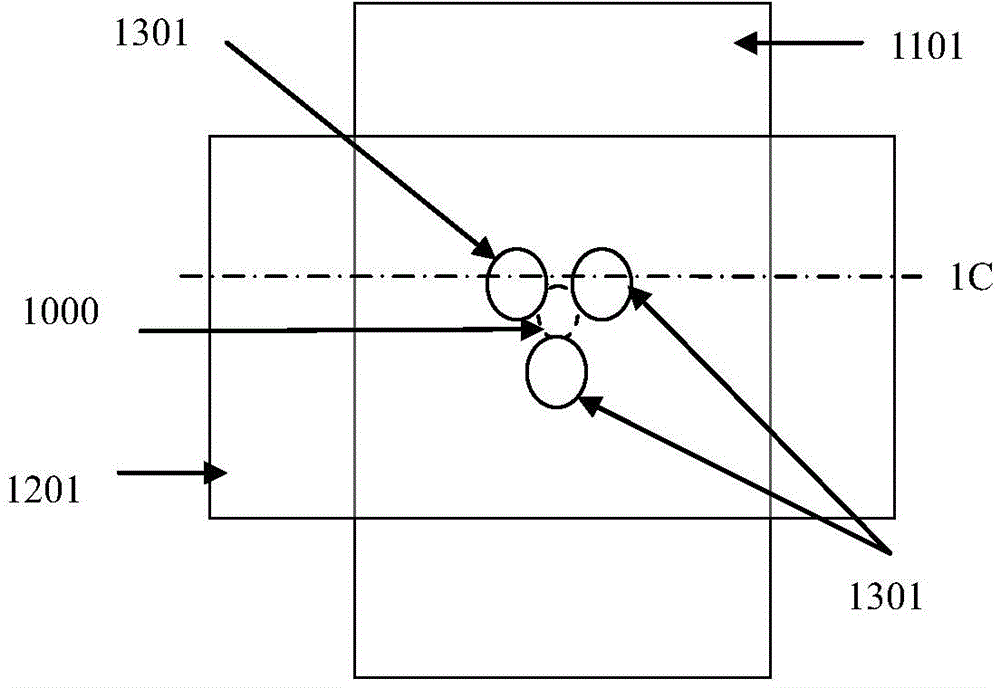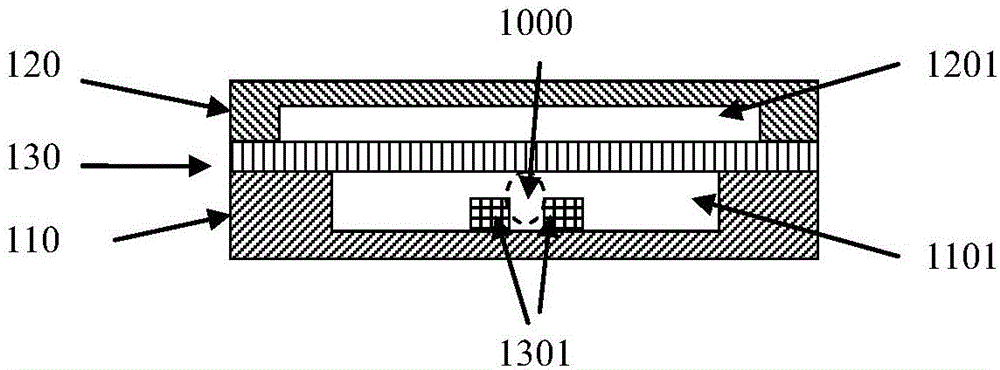A single-cell capturing chip
A single-cell and chip technology, applied in the field of microfluidics, can solve the problems of incomplete replacement of internal and external liquid, limited amount of new liquid, and reduced effect, and achieve the effect of simple and fast discrimination, low probability, and prevention of cell escape
- Summary
- Abstract
- Description
- Claims
- Application Information
AI Technical Summary
Problems solved by technology
Method used
Image
Examples
Embodiment 1
[0073] Example 1 Figure 1~3It is a schematic diagram of the single cell capture chip of Example 1 of the present invention, and the chip is mainly composed of three structural layers stacked one above the other. The bottom layer is the fluid flow layer 110, the upper layer is the pneumatic control layer 120, and there is an elastic membrane 130 between the two layers. There is a liquid flow channel 1101 in the liquid flow layer 110, with a width of 100 microns and a height of 20 microns. There are interfaces at both ends to communicate with the outside of the chip. There are three protruding micropillars 1301 at the bottom of the local area of the liquid flow channel 1101, with a diameter of 10 microns and a height of 20 microns. 10 microns, the area surrounded by the micro-pillars is the single cell capture area 1000. In the pneumatic control layer 120 there is a first pneumatic control channel 1201 with a width of 100 micrometers, passing through the liquid flow channe...
Embodiment 2
[0077] Example 2 Figure 4 , 5 It is a schematic structural diagram of the single cell capture chip in Example 2 of the present invention, and the chip is mainly composed of three structural layers stacked one above the other. The bottom layer is the fluid flow layer 110, the upper layer is the pneumatic control layer 120, and there is an elastic membrane 130 between the two layers. There is a liquid flow channel 1101 in the liquid flow layer 110, with a width of 100 microns and a height of 20 microns. There are interfaces at both ends to communicate with the outside of the chip. Three protruding micropillars 1401 protrude from the local area of the elastic membrane 130 toward the direction of the liquid flow channel. The diameter is 10 microns, the height is 10 microns, and the area surrounded by the micro-pillars is the single cell capture area 1000. In the pneumatic control layer 120 , there is a first pneumatic control channel 1201 passing over the single cell captur...
Embodiment 3
[0080] Example 3 Figure 6 , 7 It is a schematic diagram of the structure of the single cell capture chip in Example 3 of the present invention, and the chip is mainly composed of three structural layers stacked one above the other. The bottom layer is the fluid flow layer 110, the upper layer is the pneumatic control layer 120, and there is an elastic membrane 130 between the two layers. There is a liquid flow channel 1101 in the liquid flow layer 110, with a width of 100 microns and a height of 20 microns. There are interfaces at both ends to communicate with the outside of the chip. There are three protruding micropillars 1301 at the bottom of the local area of the liquid flow channel 1101, with a diameter of 10 microns and a height of 20 microns. 10 microns, the area surrounded by the micro-pillars is the single cell capture area 1000. There is a first pneumatic control pipeline 1201 in the pneumatic control layer 120 , wherein the first pneumatic control pipeline 12...
PUM
 Login to View More
Login to View More Abstract
Description
Claims
Application Information
 Login to View More
Login to View More - R&D
- Intellectual Property
- Life Sciences
- Materials
- Tech Scout
- Unparalleled Data Quality
- Higher Quality Content
- 60% Fewer Hallucinations
Browse by: Latest US Patents, China's latest patents, Technical Efficacy Thesaurus, Application Domain, Technology Topic, Popular Technical Reports.
© 2025 PatSnap. All rights reserved.Legal|Privacy policy|Modern Slavery Act Transparency Statement|Sitemap|About US| Contact US: help@patsnap.com



